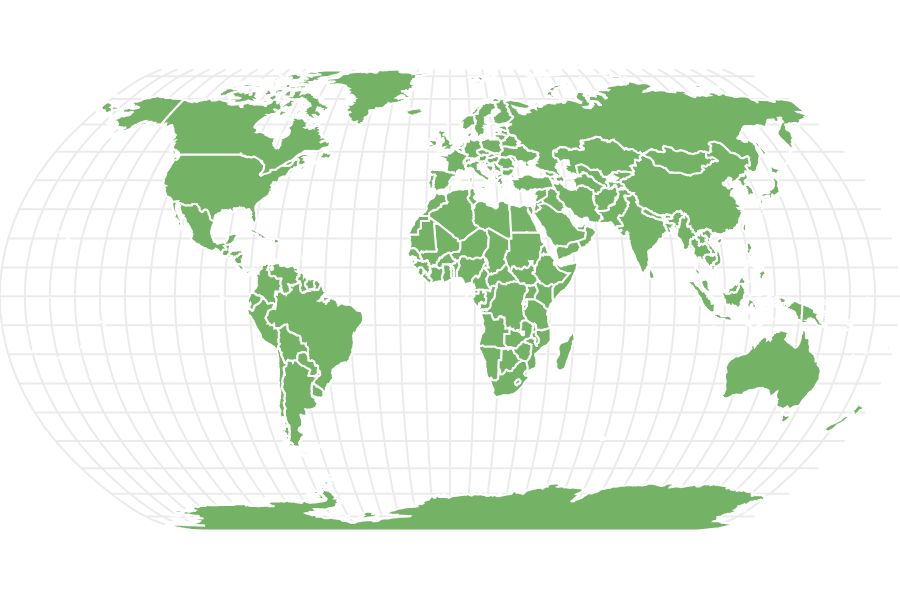Octopus
Octopus Vulgaris
There are around 300 different species!
Advertisement
Octopus Scientific Classification
- Kingdom
- Animalia
- Phylum
- Mollusca
- Class
- Cephalopoda
- Order
- Octopoda
- Family
- Octopodidae
- Scientific Name
- Octopus Vulgaris
Read our Complete Guide to Classification of Animals.
Octopus Conservation Status
Octopus Facts
- Main Prey
- Small Fish, Clams, Crabs, Snails
- Habitat
- Tropical and temperate waters worldwide
- Predators
- Eels, Seals, Sea Otters, Large Fish, Sperm Whales
- Diet
- Omnivore
- Average Litter Size
- 80
View all of the Octopus images!
The octopus holds the distinction of being the most intelligent of all invertebrate animals.
With the highest brain-to-body-mass ratios of all invertebrates – higher even than those of some vertebrates – the octopus is regarded as the smartest of all invertebrate animals. These cephalopods are intelligent enough to engage in deceitful activities, including pretending to be “moving rocks” to outwit predators. More than 300 species of octopus exist, and they are mostly found in tropical and temperate seas around the world. Octopuses are animals that have existed for many millennia; the first known octopus fossil, Pohlsepia, is believed to have lived more than 296 million years ago.
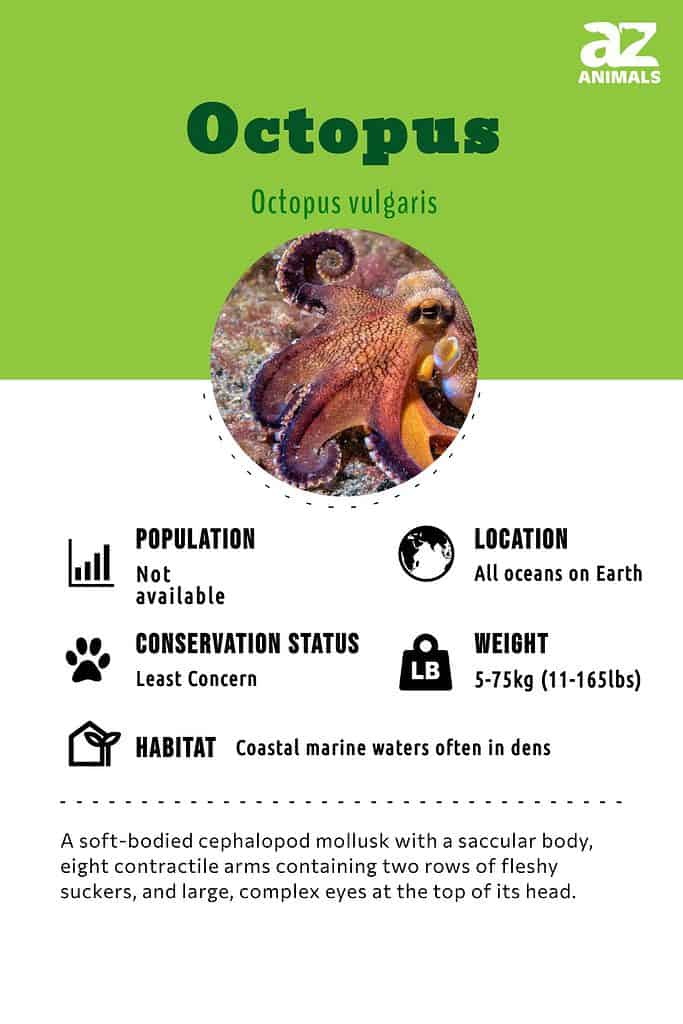
5 Amazing Octopus Facts
- Some species of octopus engage in what is known as the “moving rock” trick. An octopus may slowly inch its way across open space, allowing them to mimic the appearance of a rock. They do so at the same speed as the surrounding water, creating the illusion that they aren’t moving at all. This allows them to essentially move while in plain sight of predators.
- Maze and problem-solving experiments have suggested that octopuses have both short- and long-term memory capabilities. They can find their way back to their dens without any trouble even after traveling far distances.
- The deepest living genus of octopus is known as the dumbo octopus. Although it is very small, it lives roughly 13,100 feet below the surface of the water.
- Thanks to their highly developed pigment-bearing cells, octopuses are animals that can change the color of their skin significantly and very quickly. This camouflaging is a common defense tactic that is used to help octopuses to evade predators.
- Contrary to popular belief, the plural form of the word octopus is octopuses – not octopi. However, the term octopi is popularly used to describe more than one octopus.
Scientific Name
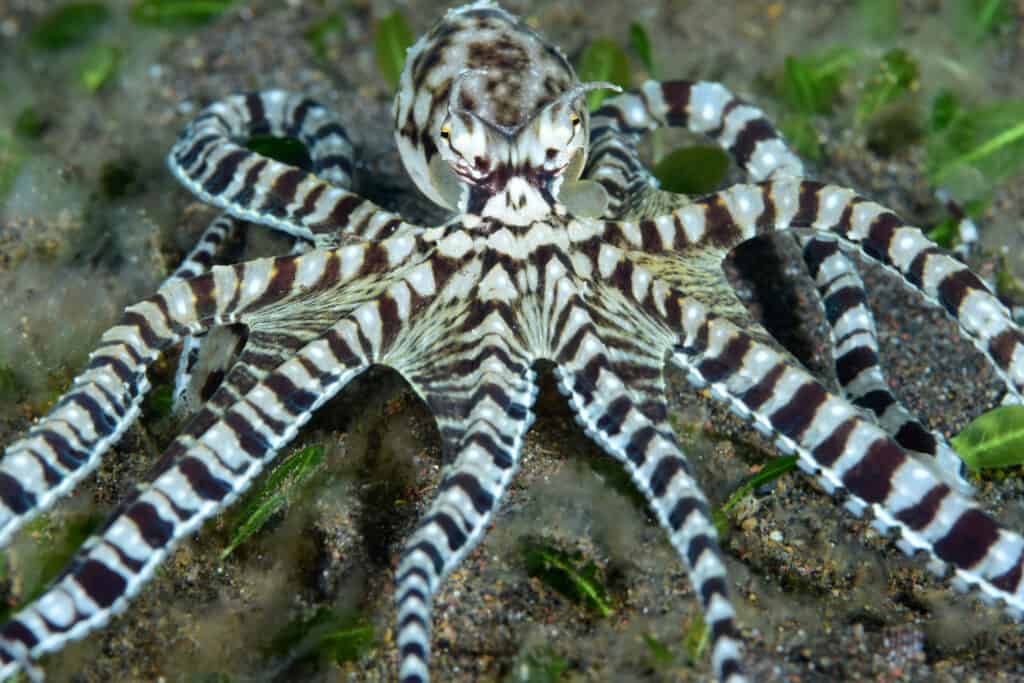
This Latin term
Octopus vulgarisis derived from the Ancient Greek words —
okto, which means “eight,” and
pous, which means “foot.”
©DiveIvanov/Shutterstock.com
Octopuses belong to the mollusk order. They fall under the classification of Cephalopoda and the order Octopoda. The term Octopoda was first coined by English biologist William Elford Leach in 1818.
The scientific name for the common octopus is Octopus Vulgaris. This Latin term is derived from a couple of Ancient Greek words — okto, which means “eight,” and pous, which means “foot.” Therefore, the term “octopus” means “eight feet,” which reflects the fact that these creatures have eight “feet,” which are more commonly referred to as arms.
Evolution of the Octopus
Some fossils were recently discovered in Avalon Peninsula, Newfoundland, and scientists believe them to be cephalopods. These fossils date back approximately 522 million years, providing the possibility that cephalopods are 30 million years older than originally believed.
Either way, these ocean animals are some of the oldest in the world. Their evolution has been thought to have begun in the late Cambrian Era, based on fossils of nautiloids that have been studied, found in areas of China, Kazakhstan, and even Texas. But if these recent fossils are verified as being cephalopods, the date would be pushed back to the early Cambrian Era.
During the Ordovician period, cephalopods diversified, and eventually dominated seas during the Paleozoic and Mesozoic seas. Their habitat was more shallow waters, and they are believed to have been predatory creatures at the top of the food chain.
Species: The Types of Octopus
There are 13 families in the order Octopoda which contains approximately 300 species. Octopuses are incredibly diverse, with some species living in the deep sea, some species reaching 30 feet, and others not even reaching an inch!
Below are some of the most fascinating species of octopus.
Giant Pacific Octopus (Enteroctopus dofleini)

The largest Giant Pacific octopus over found weighed 600 pounds and had a 30 foot arm span.
©karen crewe/Shutterstock.com
Octopuses don’t get bigger than the giant Pacific octopus! The largest specimen ever weighed a reported 600 pounds and had an arm span of 30 feet! The species ranges along the Pacific’s “ring of fire”, stretching from the Gulf of California, into Alaska, and down past Japan and into China’s coastline.
Flapjack Octopus (Opisthoteuthis californiana)
Flapjack octopuses are a species of umbrella octopus, which means they have a web of skin between tentacles. In the case of the flapjack octopus, it gets its name because its webbing connects outward to the ends of its tentacles, giving the bottom of its body an almost ‘flapjack appearance.’ Flapjack octopuses leave up to a mile below the ocean’s surface and little is known of their behavior. Popularity in flapjack octopuses soared after the character Pearl in Finding Nemo was modeled after the species.
Atlantic Pygmy Octopus (Octopus joubini)
The Atlantic pygmy octopus’s arms reach just under 4″, making it one of the smaller species of octopus. They’re especially abundant in the Gulf of Mexico and are known for their ability to rapidly change colors to mimic their surroundings.
Blue-ringed Octopus
The blue-ringed octopus isn’t a species, but rather a genus. The species is notable for its color, with blue rings across its body that are extremely bright. In addition, blue-ringed octopus species are extremely venomous and their bite contains the neurotoxin tetrodotoxin. There is no known antidote to this toxin which causes temporary paralysis. If bitten by a blue-ringed octopus, the paralysis lasts approximately 15 hours and may require intubation for survival. However, the blue-ringed octopus is not aggressive and a 2008 study found just 3 known fatalities linked to the species.
Appearance and Behavior
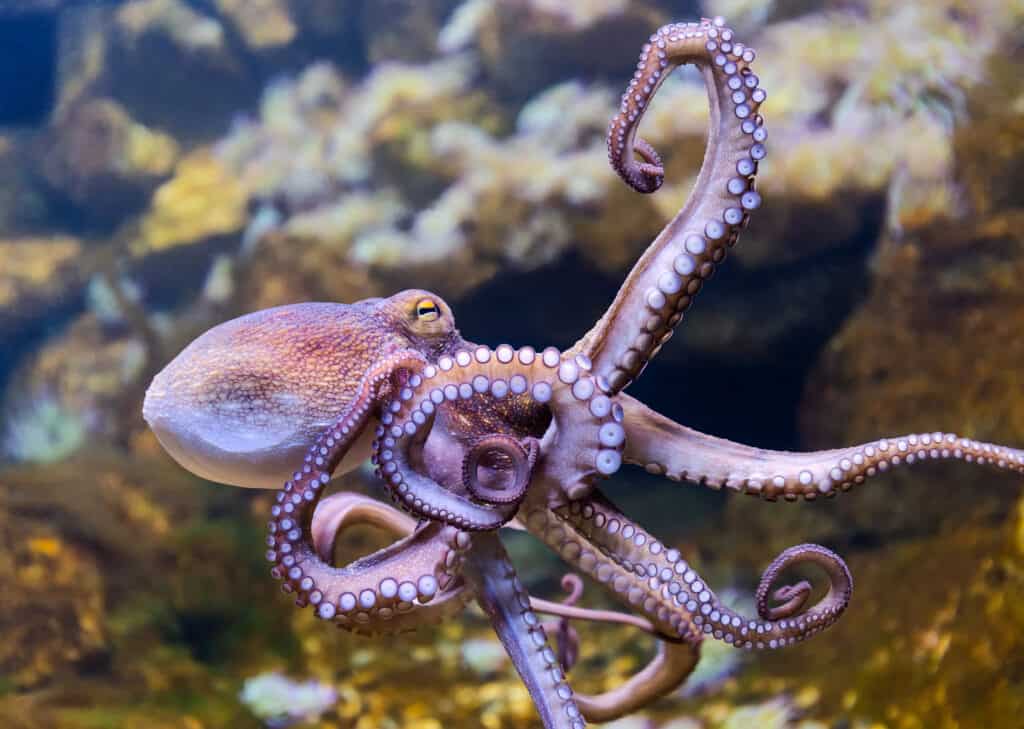
Octopuses have eight contractile arms, with each one containing two rows of fleshy suckers.
©Henner Damke/Shutterstock.com
An octopus is defined as any eight-armed cephalopod mollusk of the order Octopoda. True octopuses belong to the genus Octopus, a massive group of broadly distributed shallow-water cephalopods that also includes squids and cuttlefish.
The typical octopus has a saccular body, which means that its head is only slightly defined from its body. They have eight contractile arms, and each one contains two rows of fleshy suckers. Their arms are joined at their bases by a web of tissue that’s known as a skirt; their mouth is found in the center of the skirt and doesn’t contain teeth, but instead has a pair of sharp beaks and a file-like organ known as a radula.
Octopuses’ soft bodies can change shape rapidly, allowing them to squeeze through very small spaces. Even the largest species of octopus can pass through openings as small as 1 inch in diameter. They also have a hollow, bulbous mantle that is fused to the back of their head; it contains most of the creature’s vital organs, including its gills, and it connects to the exterior through a funnel or siphon. Their large, complex eyes are located on the top of their head.
As noted earlier, the largest specimen of the giant Pacific octopus on record had a 30-foot arm span and weighed approximately 600 pounds. The smallest octopus species weigh less than one gram and measure only about 1 inch in length.
Octopuses engage in respiration by drawing water into their mantles through an aperture. It then passes through the gills before being expelled by the siphon. Octopuses’ thin skin also absorbs some oxygen from the water. Another distinctive feature is that octopuses have three hearts. Two hearts pump blood through their gills while a third pumps blood throughout the body of octopuses.
These creatures move in a variety of ways. They crawl using their front two arms, using the other six for foraging. They swim by moving water through their siphons; when doing so, their arms trail behind them. They can also move backwards rapidly by ejecting jets of water from their siphons.
Octopuses are also known for ejecting ink. They do this to evade predators; the cloud of ink, which is black in color, masks them so that they can move away quickly. In some species, the ink contains a venom that paralyzes the sensory organs of the attacker. Only one species of octopus, the blue-ringed octopus, is poisonous to humans. In this case, they inject prey with paralyzing saliva.

Octopuses have an excellent sense of touch, and can taste whatever they touch with the chemoreceptors on their suction cups.
©albert kok, CC BY-SA 3.0, via Wikimedia Commons – License
Most octopuses are solitary and spend roughly 40 percent of their time hiding in dens. However, some are social and may live in groups of up to 40 other individuals. They are not territorial, but they typically stay within a defined home range. They aren’t migratory, so they spend their whole lives in the same general area.
Octopuses also have an excellent sense of touch. Thanks to chemoreceptors on their suction cups, they can taste whatever they touch. Their skin also contains highly developed pigment-bearing cells called chromatophores that allow them to change the color, opacity, and even reflectivity of their skin quickly.
Finally, octopuses are the most intelligent of all invertebrate animals. The veined octopus, Amphioctopus marginatus, was observed in 2009 excavating coconut half shells from the ocean floor and using them as part of its den. This was the first documented use of tools by an invertebrate and is further evidence of how intelligent these creatures are.
Habitat
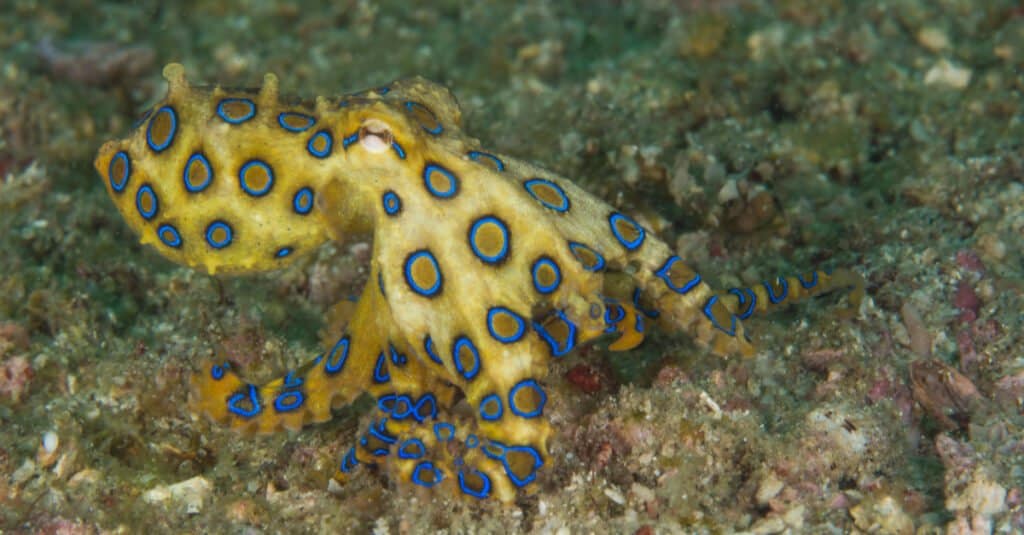
Various species of octopus are found in places like coral reefs, seabeds and pelagic waters.
©JumKit/Shutterstock.com
The common octopus, O. vulgaris, primarily lives in tropical and temperate seas around the world. These creatures typically live in dens that are found in holes or crevices along the rocky bottom of the sea, which is in line with their retiring and secretive nature. Various species of octopus are found in places like coral reefs, seabeds, and pelagic waters. However, some are found in intertidal zones, and others are found in abyssal depths. The dumbo octopus, for example, lives an average of 13,100 feet below the surface.
Do Octopus Make Good Pets?
Octopuses have become increasingly popular pets for aquarium enthusiasts. However, it needs to be noted that they’re only for experienced hobbyists. There are several challenges for keeping octopuses in tanks that include needing large tanks, feeding them a specialized diet (octopuses can be picky eaters), and maintaining pH levels that don’t harm the skin of any pet octopuses.
Diet
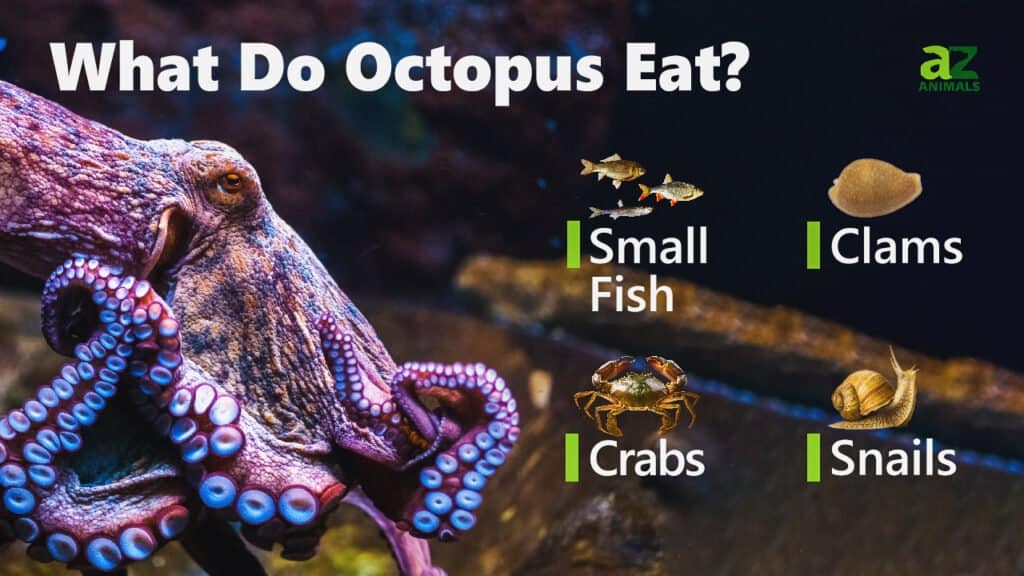
Octopuses are carnivores because they subsist solely on other creatures. In particular, they mostly feed on crabs and other crustaceans. Lobsters are also popularly consumed, and some species of octopus are known to eat plankton. Predatory, bottom-dwelling species of octopus primarily live off of crustaceans, Polychaeta worms and clams, and other mollusks. Open-ocean species of octopus primarily consume other cephalopods, prawns, and fish. When feeding, they bring prey back to their dens and use their radula to drill shells and rasp away flesh. They use their very sharp beaks to tear apart prey.
Predators and Threats
According to the IUCN, most species of octopus are not endangered. Recent studies have suggested that populations may be booming. However, these creatures do face numerous threats. Considered a delicacy by many cultures, they are hunted regularly by humans. Therefore, humans are among the octopus’s top predators.
In the wild, octopuses are preyed upon by many other creatures. A variety of marine fishes are known to consume octopuses, for example. Other common predators include seabirds, other cephalopods, and sea otters.

One of the top predators of the octopus is humans.
©Dima Sobko/Shutterstock.com
Reproduction, Babies and Lifespan
There are separate sexes of octopuses. The male octopus has a specialized arm called a hectocotylus. This appendage inserts packets of sperm, which are known as spermatophores, directly into the mantle cavity of female octopuses. During reproduction, the male typically clings to the top or side of the female or hovers beside her. After delivering the spermatophores, males become senescent, which means that they gradually deteriorate before dying. Most die within about two months.
Eggs, which are about 1/8th of an inch long, are laid by female octopuses in holes and under rocks. On average, females lay around 100,000 eggs at one time, and it takes between four to eight weeks for them to hatch. During this period, the female octopus guards the eggs and cleans them with her suckers. She also agitates them with water. Once they hatch, miniature versions of the parents – tiny octopods – emerge. They spend several weeks drifting in the plankton before taking refuge at the bottom of the sea. No parental care is provided beyond the care that is given by the female while waiting for eggs to hatch, so baby octopuses are on their own.
Most species of octopus, including the common octopus, mate during the winter. Unless they are mating, they are typically solitary. Octopuses have fairly short lifespans, with some species only living for an average of six months. However, the giant Pacific octopus is known to live for up to five years. These creatures’ lifespans are limited by reproduction since males only live for a few months afterward and females typically die shortly after eggs are hatched.
Population
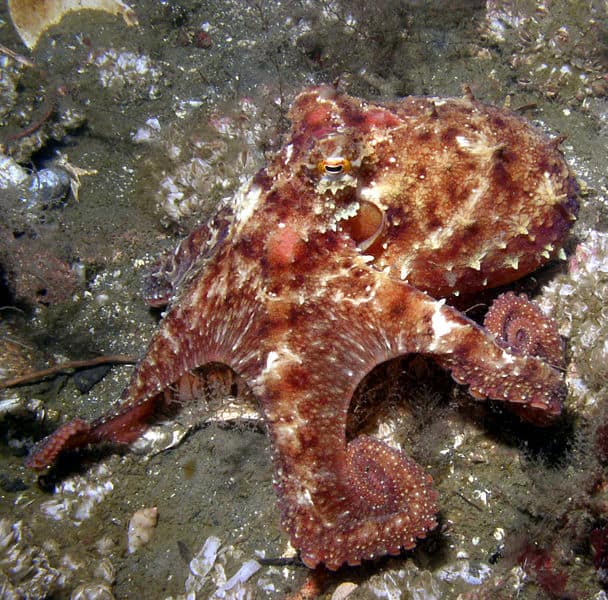
There’s not enough tracking data for scientists to estimate how many octopuses inhabit the oceans of the world.
Unfortunately, scientists have no precise idea about how many octopuses exist in the world. They aren’t easy to track not only because they can’t be tagged but also because they are so solitary and reclusive. However, it is believed that the population of cephalopods, including octopuses, has boomed significantly since the 1950s. There are various pieces of evidence to support this, but again, specific numbers are not available.
Why are cephalopod – and, by extension, octopus – populations growing? Researchers believe that a few different factors are at work. For one, these creatures are known to be highly adaptable to changing environments. As climate change occurs and, for example, ocean temperatures rise, they may be better able to cope than other creatures. Human activity is also believed to play a role in population increases. In particular, human fishing removes large numbers of octopuses’ natural predators from the sea. This creates a gap in the food chain that may be advantageous to these eight-armed creatures.
Types of Octopuses
There are many different types of octopus in the Earth’s oceans–300 known species to be exact. A list of different octopus types is found below:
- Mosaic Octopus (Octopus abaculus) – The body of the Mosaic Octopus is covered in small spiked patches to help them blend in to ocean floor terrain. Native to Indonesia.
- Algae Octopus (Abdopus aculeatus) – The Algae Octopus, which is tiny in size, has an appearance of algae to acmouflage itself. These octopuses are tiny.
- Sandbird Octopus (Amphioctopus aegina) – The Sandbird Octopus is hunted by humans for native cuisine in the Indo-West Pacific oceans around Mozambique, the Red Sea, and Japan.
- Capricorn Octopus (Callistoctopus alphaeus) – Capricorn Octopuses are nocturnal, emerging from their dens to hunt at night. Native to Australia.
- Greater Blue-Ringed Octopus (Hapalochlaena lunulata) – While the Greater Blue-Ringed Octopus has striking blue rings and bright yellow and orange spots, it’s venomous, and probably the most toxic of all marine animals.
- Southern Blue-Ringed Octopus (Hapalochlaena maculosa) – The Southern Blue-Ringed Octopus is also venomous, and inhabits the tidal rock pools off the southern coast of Australia.
- Mimic Octopus (Thaumoctopus mimicus) – The Mimic Octopus can reshape its body, and has brown and white striped patterns on its body that act as a camouflage, helping it to impersonate other dangerous marine animals.
- Giant Pacific Octopus (Enteroctopus dofleini) – The Giant Pacific Octopus is a gargantuan octopus, the largest recorded in The Guinness Book of World Records as weighing 300 pounds. These creatures inhabit the coastlines of the United States, Canada, Alaska, Russia and Southeast Asia.
- Seven-Arm Octopus (Haliphron atlanticus) – The Seven-Arm Octopus earned its name for the appearance of seven arms, while it has an eight hidden arm used for mating.
- Dumbo Octopus (Grimpoteuthis) – The Dumbo Octopus is the deepest ocean dwelling octopus species. The fins on their mantle look like the ears of the animated Disney character Dumbo.
- Coconut Octopus (Amphioctopus marginatus) – Coconut Octopuses use two of their legs to walk on the ocean floor while holding a coconut shell on their heads with other arms, giving the appearance of a coconut shell shifting in the waves.
- Common Blanket Octopus (Tremoctopus violaceus) – The Blanket Octopus has transparent webbing between its dorsolateral and dorsal arms that looks like blankets, which they use to increase their size when threatened.
- Hammer Octopus (Octopus australis) – Hammer Octopuses inhabit Australia’s subtropical waters from Queensland to New South Wales.
- Southern Keeled Octopus (Octopus berrima) – The Southern Keeled Octopus gets its name from the skin-keel formed on the edge of its mantle. Its endemic to the coastal waters in Australia.
- California Two-Spot (Octopus bimaculoides) “Bimac.” They are called “two-spot” octopuses. The name is because of the circular blue spots on either side of their head, distracting prey from their real eyes on their mantle.
- Caribbean Reef Octopus (Octopus briareus) -Carribean Reef Octopuses live in shallow-water along the coastlines of Mexico, the Bahamas, and the West Indies.
- Lillliput Longarm Octopus (Macrotritopus defilippi) – The Lilliput Longarm Octopus has very long arms extending from a small body. It inhabits the Caribbean, Indian Ocean, and the Mediterranean Sea.
- Atlantic Pygmy Octopus (Octopus Roubini) – The Atlantic Pygmy or Dwarf Octopus is the smallest octopus in the ocean, and has a talent for hiding from predators.
- East Pacific Red Octopus (Octopus rubescens) – Also known as the Red Octopus, it sports a gorgeous red color resembling reefs and rocks in its ocean habitat. They feed in depths of 1000 feet otherwise inhabit more shallow water along the West Coast of North America.
- Common Octopus (Octopus vulgaris) – The Common Octopus is found in varied habitats and depths. all over the world.
- Star-sucker Pygmy Octopus (Octopus wolfi) – The Star-sucker Pygmy Octopus, found in shallow waters, is small, colored sandy orange, and has cute small arms lined with suckers.
- Flapjack Octopus (Opisthoteuthidae californiana) – The Flapjack Octopus is a type of umbrella octopus that has webbing between each arm to create an umbrella shape when it swims or floats.
More on Octopuses
View all 66 animals that start with OOctopus FAQs (Frequently Asked Questions)
Are octopuses carnivores, herbivores or omnivores?
Octopuses consume no plant materials and primarily feed on crustaceans, mollusks, prawns and fish. Therefore, they are classified as carnivores. They are adapted to be fierce predators that are able to attack and paralyze prey with relative ease. They also have defense mechanisms, including venomous saliva and ink screens, that allow them to outwit their prey – and many of their predators.
Can octopuses kill humans?
Although all octopuses are technically venomous, only one species of them is capable of killing humans with venom: the blue ringed octopus. In fact, the venom of this octopus is strong enough to kill 10 grown men at one time. The venom, a neurotoxin called tetrodotoxin, causes respiratory arrest in those who are subjected to it. Tetrodotoxin is 1,000 times more powerful than cyanide and is therefore highly lethal to most creatures.
Is an octopus a fish?
Although octopuses live underwater and even have gills like fish, they are not fish at all. The two creatures do have a “shared cousin,” but it existed more than 500 million years ago. Octopuses are actually a type of mollusk – like a snail – which is in turn a type of cephalopod. Therefore, it is erroneous to refer to octopuses as fish.
How many hearts does an octopus have?
Octopuses have three hearts. They have a single systemic heart, which is responsible for circulating blood throughout their bodies. They also have two branchial hearts – one for each set of gills – that pump blood through the gills.
Does an octopus have nine brains?
Technically speaking, octopuses have nine brains. The central brain controls the octopus’s nervous system. There are also small “brains” in each arm, bringing the total up to nine. These small brains are clusters of nerve cells that allow each arm to work independently of each other.
What Kingdom do Octopuses belong to?
Octopuses belong to the Kingdom Animalia.
What phylum do Octopuses belong to?
Octopuses belong to the phylum Mollusca.
What class do Octopuses belong to?
Octopuses belong to the class Cephalopoda.
What family do Octopuses belong to?
Octopuses belong to the family Octopodidae.
What order do Octopuses belong to?
Octopuses belong to the order Octopoda.
What type of covering do Octopuses have?
Octopuses are covered in Smooth skin.
In what type of habitat do Octopuses live?
Octopuses live in tropical and temperate waters worldwide.
What is the main prey for Octopuses?
Octopuss prey on crabs, fish, and scallops.
What are some predators of Octopuses?
Predators of Octopuses include eels, sharks, and dolphins.
What is the average litter size for an Octopus?
The average litter size for an Octopus is 80.
What is an interesting fact about Octopuses?
There are around 300 different Octopus species!
What is the scientific name for the Octopus?
The scientific name for the Octopus is Octopus Vulgaris.
What is the lifespan of an Octopus?
Octopuses can live for 2 to 15 years.
How fast is an Octopus?
An Octopus can travel at speeds of up to 27 miles per hour.
How do Octopuses have babies?
Octopuses lay eggs.
Who would win a fight between a shark
A shark would win a fight against an octopus. Although we can find cases where an octopus kills a smaller shark, the size disparity is simply too much for an octopus to overcome. Even if the octopus uses camouflage, it can’t hide from a shark completely. Remember, they don’t need to see their prey to hunt them since they can smell very well and detect electrical fields coming from aquatic animals.
Thank you for reading! Have some feedback for us? Contact the AZ Animals editorial team.
Sources
- David Burnie, Dorling Kindersley (2011) Animal, The Definitive Visual Guide To The World's Wildlife
- Tom Jackson, Lorenz Books (2007) The World Encyclopedia Of Animals
- David Burnie, Kingfisher (2011) The Kingfisher Animal Encyclopedia
- Richard Mackay, University of California Press (2009) The Atlas Of Endangered Species
- David Burnie, Dorling Kindersley (2008) Illustrated Encyclopedia Of Animals
- Dorling Kindersley (2006) Dorling Kindersley Encyclopedia Of Animals

